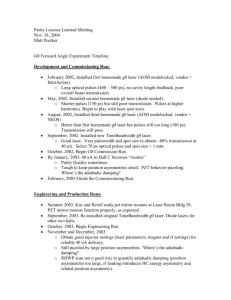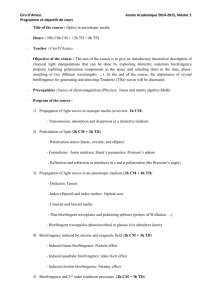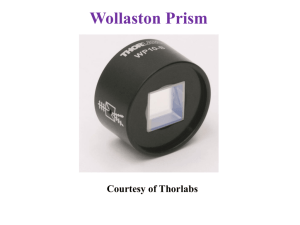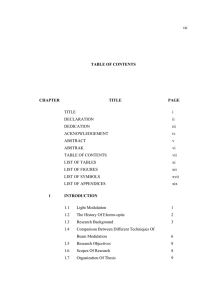Aligning the pockels cell – the HAPPEx approach
advertisement
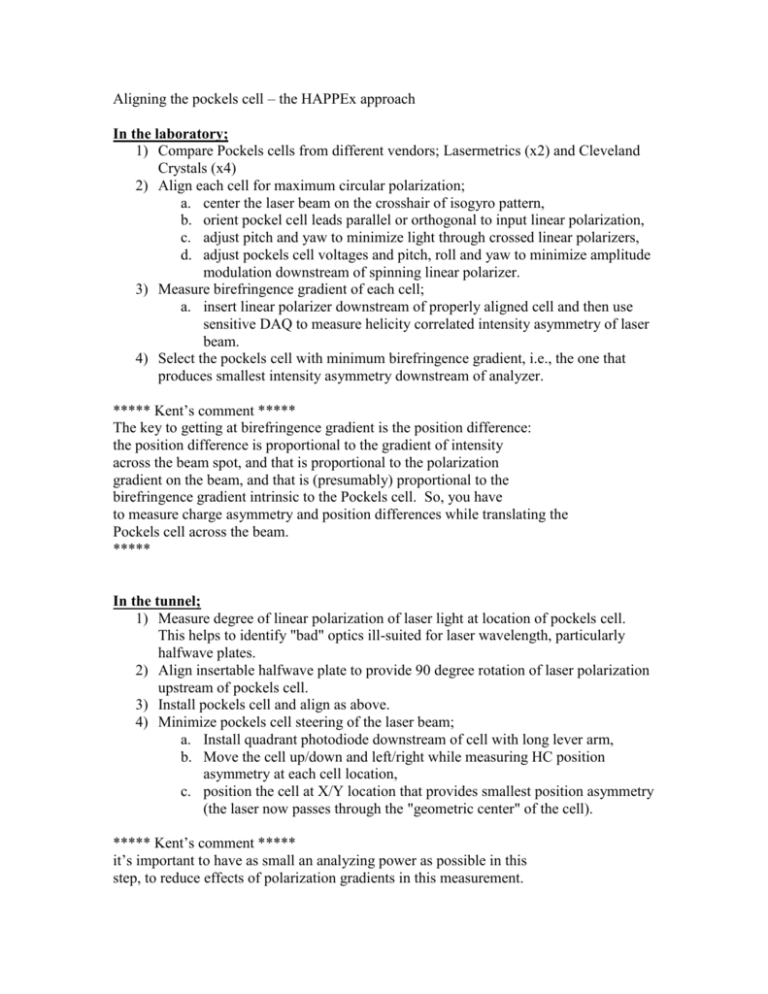
Aligning the pockels cell – the HAPPEx approach In the laboratory; 1) Compare Pockels cells from different vendors; Lasermetrics (x2) and Cleveland Crystals (x4) 2) Align each cell for maximum circular polarization; a. center the laser beam on the crosshair of isogyro pattern, b. orient pockel cell leads parallel or orthogonal to input linear polarization, c. adjust pitch and yaw to minimize light through crossed linear polarizers, d. adjust pockels cell voltages and pitch, roll and yaw to minimize amplitude modulation downstream of spinning linear polarizer. 3) Measure birefringence gradient of each cell; a. insert linear polarizer downstream of properly aligned cell and then use sensitive DAQ to measure helicity correlated intensity asymmetry of laser beam. 4) Select the pockels cell with minimum birefringence gradient, i.e., the one that produces smallest intensity asymmetry downstream of analyzer. ***** Kent’s comment ***** The key to getting at birefringence gradient is the position difference: the position difference is proportional to the gradient of intensity across the beam spot, and that is proportional to the polarization gradient on the beam, and that is (presumably) proportional to the birefringence gradient intrinsic to the Pockels cell. So, you have to measure charge asymmetry and position differences while translating the Pockels cell across the beam. ***** In the tunnel; 1) Measure degree of linear polarization of laser light at location of pockels cell. This helps to identify "bad" optics ill-suited for laser wavelength, particularly halfwave plates. 2) Align insertable halfwave plate to provide 90 degree rotation of laser polarization upstream of pockels cell. 3) Install pockels cell and align as above. 4) Minimize pockels cell steering of the laser beam; a. Install quadrant photodiode downstream of cell with long lever arm, b. Move the cell up/down and left/right while measuring HC position asymmetry at each cell location, c. position the cell at X/Y location that provides smallest position asymmetry (the laser now passes through the "geometric center" of the cell). ***** Kent’s comment ***** it’s important to have as small an analyzing power as possible in this step, to reduce effects of polarization gradients in this measurement. ***** 5) Finish by measuring the effective "analyzing power" of the aligned laser system (pockels cell and all optical components, except the vacuum window). This provides a measure of the uniformity of the laser polarization across the beam profile and helps distinguish effects associated with steering and birefringence gradient. Procedure; a. insert linear polarizer downstream of cell and measure HC intensity asymmetry versus pockel cell voltages. The HC intensity asymmetry data should be centered about 0 at the ideal cell voltages. ***** Kent’s comment ***** The key here really isn't measuring the analyzing power... that is somewhat arbitrary as the cathode presumably dominates the analyzing power in the real setup, and in this test the extra pick-off mirrors might dominate. The analyzing power measurement made at this time is used to understand where other position differences come from. Ideally, one compares position differences (at this long lever arm) with and without an analyzer, and with and without the IHWP, to separate birefringence-caused position differences and steering/lensing-caused position differences. ***** Now with beam; 1) Measure HC charge and position asymmetry using a rotating halfwave plate downstream of the pockels cell with cell voltages for "ideal" circular polarization (as found in the tunnel) for insertable halfwave plate IN/OUT. HC asymmetries should be small for properly aligned cell with small birefringence gradient that is centered on geometric axis, uniform laser polarization and vacuum window with uniform index of refraction. ***** Kent’s comment ***** And, of course, various sources of position difference and charge asymmetry stand out from the "constant" term, or the terms that change as sin(2*theta) or sine(4*theta) of the halfwave plate angle, so it is a very rich data set. But certainly, it is as you say: HC asymmetries will be small if those components are ideal. ***** 2) Repeat above but for cell voltages offset by ~ 200 V, to induce significant linear polarization. Compare results to step 1. If charge asymmetry and position asymmetry track each other, HC asymmetries stem mostly from the analyzing power gradient of the photocathode (i.e., the QE anisotropy of the photocathode, for different orientations of residual linear polarized light). This is a good condition. If position and charge asymmetry do not track each other, other effects are involved, e.g., pockels cell steering and pockels cell birefringence gradient. ***** Kent’s comment ***** I guess if you have any one effect, then it’s a pretty good condition. If you have competing effects, you have to find a suitable compromise between them, so things get harder. (What you'd like to do to minimize one accentuates another.) ***** 3) Minimize charge and position asymmetries through careful choice of rotating halfwave plate orientation and pockel cell voltages. Adjustments to these parameters are made on a XX-time scale. ***** Kent’s comment ***** Ah, the time scale. Well... we found excellent stability when running off the strained layer cathode, so I would expect that they would not require detailed examination more than once a week, and maybe not even that often (detailed means RHWP scan). The PITA scans were done roughly 2-3 days, and the Pockels cell voltages were changed as required to keep the charge asymmetry <100 ppm (leaving the rest for the IA cell), usually 1-2 time daily. It is certainly possible that closer attention to these parameters may have helped damp position difference. It is also not clear that changes in injector transmission or the interaction with the Hall C beam on the cathode may have also been important. We're still trying to sort out this information. *****
